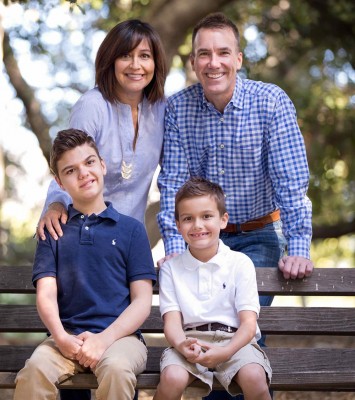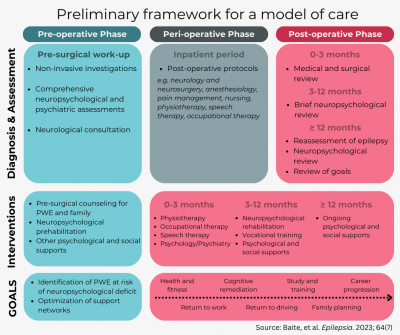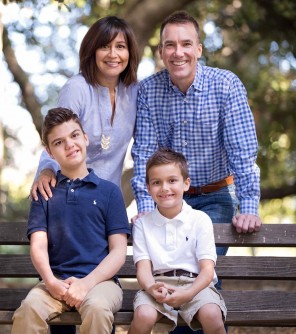By Joy Mazur, Epigraph intern
Newswise — Monika Jones jokes that after her son’s epilepsy surgery, the neurosurgeon handed her the three-month-old with 65 staples in his head and one instruction: “Good luck; get a lot of therapy.”
“I thought, ‘You gotta be kidding. What do I do?’” said Jones, now the founder and executive director of the nonprofit Pediatric Epilepsy Surgery Alliance.
Before surgery, people with epilepsy undergo an in-depth process involving lengthy evaluation, extensive testing, and lots of time with medical teams. But after surgery, some professionals and advocates argue, people are unfairly left to manage treatment and care without much help or guidance.
Jones’ son Henry was born with hemimegaloencephaly, which caused hundreds of seizures a day. Henry underwent several surgeries.
Jones and her husband struggled to find information about post-op care for their baby. Their frustration with the lack of resources spurred them to start the nonprofit, which funds surgery research and provides support services and programs for the families of children with epilepsy.
“Parents deserve to have that information at their fingertips,” Jones said. “They all say, ‘We don’t feel like we had a roadmap for all the different things that can happen after surgery.’”
Postoperative rehabilitation
There remains a lack of consensus on best practices regarding postoperative rehabilitation, which can vary widely from center to center. While guidelines for post-surgical care have been implemented for other neurosurgical procedures, none have been developed or adapted for epilepsy.
Common challenges for people after epilepsy surgery include changes in self-concept, behavior and activity, mood, family dynamics, and access to social and vocational opportunities. People with a long history of epilepsy may also have trouble adapting to life without seizures, an effect called the “burden of normality.”
There is evidence that cognitive rehabilitation improves cognitive and functional performance in people with cognitive decline after surgery, but it remains under-researched and underreported. Although determinants such as cognitive, psychiatric, quality-of-life, and psychosocial outcomes remain important to people undergoing surgery, they’re often less defined and targeted factors of postsurgical care.
Rehabilitation programs may also help reduce unemployment rates for adults after surgery. For children, Jones believes there should be more support in navigating life in school postoperatively.
“Do the teachers understand how to teach a child how to read when they can only see half a word at a given time, or when their ocular motor control isn’t perfect?” she said.
In one instance, Jones said a family working with the nonprofit had to send their child outside the school district because he wasn’t being taught how to read, despite exhibiting pre-literacy skills.
“Making sure that the kids get intensive intervention in an appropriate environment is also important,” Jones said.
Managing outcome expectations
Now 16, Jones’ son is nonverbal and has an intellectual disability, as well as hydrocephalus. But that doesn’t mean his surgeries failed.
“I think laypeople might look at him and think surgery was unsuccessful because he’s not ‘normal,’” Jones said. “My son is doing one thousand times better than he would have been if he had not had surgery.”
Jones said it’s important to acknowledge that children do have challenges postoperatively, and that clinicians should exercise caution when helping parents manage their surgery outcome expectations. She also emphasizes that throughout treatment, physicians and centers must remember that many parents and caregivers are in survival mode and require extra patience and empathy.
“We still don’t have a comprehensive understanding of functional outcomes postoperatively,” she said. “Even the ones that we do understand I think can sometimes be minimized by the surgical community.”
When psychologist Mary Lou Smith began practicing several decades ago, she said clinicians and researchers were much more optimistic about surgery outcomes. They believed surgery would not only stop seizures, but also would allow for restoration of brain function as a whole.
“Our surgical team would often talk to parents about these anticipated improvements,” said Smith, professor emeritus of psychology at the University of Toronto - Mississauga. “Well, that’s not necessarily what we see when we follow these children and these families after their surgery.”
Because of these misconceptions, Smith and her colleagues launched a research program to evaluate surgery outcomes. They found that regardless of whether children were treated with surgery or medical therapy, seizure control was the most important factor contributing to health-related quality of life.
“That’s good news, in a way,” Smith said. “What we didn’t see is that…there was any particular disadvantage of the brain surgery at all.”
Multiple studies from Smith’s team also have found that:
- Children with drug-resistant epilepsy reported improvements in anxiety and depression regardless of seizure control status in the two years after surgery.
- The largest improvement in health-related quality of life occurred in the first six months after surgery.
- Children who underwent surgery had greater improvements in social functioning than those undergoing medical therapy.
Epilepsy surgery has come a long way since Smith started her research —she said that now, professionals are much more cautious about the promises they make to parents and children.
Surgery community and clinician accessibility
Before her 2016 surgery, Stacia Kalinoski was in a state of denial.
“I didn’t know anybody with epilepsy leading up to surgery,” she said. “I didn’t want to talk to anybody else.”
Looking back, Kalinoski thinks it a shame that she wasn’t part of a support group during her surgery process about seven years ago. Now, she’s part of a virtual group through the Epilepsy Foundation, where she gives advice and encourages others to pursue surgery. She also produced a documentary about epilepsy to increase awareness about surgery and gives public talks on the topic.
“I’m glad to give that voice, because people are scared,” Kalinoski said. “Surgery is life changing.”
Regardless of surgery outcomes, many who have undergone the process cite community and accessibility to clinicians afterwards as a necessity.
Linda McClure, who had her first surgery at 49 and underwent three surgeries over the course of two years, underscores this point. She volunteers in a seizure unit with her best friend, who also had epilepsy surgery.
“It gives people an opportunity to talk to somebody that’s been in that bed,” she said.
Despite less than optimal outcomes, McClure said she’s still satisfied with her surgery experience because of the capability and accessibility of her medical team, who were available to answer questions by phone between clinic visits.
Multiple studies note that some people who continue to have seizures after surgery still report improvements in quality of life. A recent study with a small sample size noted that out of seven participants with continued seizures post-op, five considered the surgery at least beneficial, and none considered it harmful.
Even when surgery results in seizure freedom, post-surgery treatment includes many factors and behaviors that require attention to maximize quality of life.
“Seizures are but one symptom of the underlying brain dysfunction,” Smith said. “This underscores the need for psychosocial care and neuropsychological care after surgery.”
In a post-surgical follow-up with a teenager and his father, Smith found that the teen was seizure free, but had behavioral and emotional issues, stress, anxiety, and social issues.
“The dad said… ‘No seizures, that’s great,’” Smith said. “‘But now we have to unpack the rest of it.’”
##
Founded in 1909, the International League Against Epilepsy (ILAE) is a global organization with more than 125 national chapters.
Through promoting research, education and training to improve the diagnosis, treatment and prevention of the disease, ILAE is working toward a world where no person’s life is limited by epilepsy.
Website | Facebook | Instagram | YouTube
Twitter: English French Japanese Portuguese Spanish
MEDIA CONTACT
Register for reporter access to contact detailsArticle Multimedia

Credit:
Caption: Monika Jones and family

Credit:
Caption: Dr. Mary Lou Smith (Canada)

Credit:
Caption: Proposed framework for a model of care that centers the goals of people undergoing surgery and incorporates pre- and postoperative interventions. Adapted from Baite, et al. Epilepsia. 2023; 64(7).

Credit:
Caption: Stacia Kalinoski

Credit:
Caption: Linda McClure





